Chapter Ten—
Advice to the Nobility in Manuscripts Produced in the Style of the Master of the Cité des Dames
A second group of manuscripts, painted for the nobility and members of the court in the style of the Master of the Cité des Dames[1] during the early fifteenth century, are noteworthy for their response to contemporary events rather than any generalized ties to the religion royale . Their designers seem to have taken the admonition of the prologue to heart; in a pictorial program tied strongly to the complex and unsettled history of early fifteenth-century France, they guide the reader to "find good and evil, the beautiful and ugly, sense and folly, and to profit from all [this] through the example of history."[2]
The Master of the Cité des Dames popularized a new mode of courtly illustration during the latter part of the reign of Charles VI. One reason for his popularity in courtly circles was probably his realistic style; he could evoke the interiors where the courtiers lived and the clothing and political emblems that they loved to wear,[3] yet he could also strip settings and costumes to their essential elements if that was more appropriate to the cycle.
Books produced by the Master of the Cité des Dames are an ideal source for exploring the kind of political guidance given to the nobility during the period of the French civil war. Four cycles by this artist survive, dating approximately from 1405 to 1415: Mazarine 2028, c. 1405–08; Phillipps 1917, c. 1409–10/15; M. 536, c. 1410–12; and B.R. 3, c. 1410–15.[4] The number of cycles in this style makes it relatively easy to screen out stock workshop scenes and concentrate instead on pictures that were specially tailored for one or more of these manuscripts. Analyzed in this way, the pictures clearly offer varied but timely advice to those charged with ensuring stable government in France—advice similar to that written by partisans of the political parties and by moderates like Christine de Pizan and Jean Gerson.
Manuscripts produced for the court by the Master of the Cité des Dames diverge from the pattern of illustration in such royal copies as Philip III's, John the Good's, or Charles V's, whose carefully coordinated pictures and texts together convey a political message. They differ too from courtly commissions whose pictures bear a looser relationship to their text and work to reinforce general royalist or universal themes in the chronicle. In the new mode, important political commentary appears in manuscripts made for the princes of the blood or for their supporters.
In the most sophisticated of these books, exemplified here by a chronicle in New York (M. 536), the text is edited to emphasize Burgundian interests, and the pictures form a tightly woven cycle that provides an independent counterpoint to the text. This appropriation of an illustrational mode hitherto restricted to royal copies of the chronicle provides an interesting parallel to political developments in France, where the queen and the princes of the blood were increasingly involved in royal government (and thus in the kind of history traditionally recorded in the Grandes Chroniques ) and where writers independent of the court sought to preserve the monarchy.
The Grandes Chroniques now in Berlin (Phillipps 1917) differs radically from that in New York. Its text is conventional, and its illustrations incorporate fifteenth-century political devices and emblems into historical images to provide a commentary on the present. This method of glossing illustration to make a political statement is only as sophisticated as the editor of the book chooses to make it.[5]
Not all the manuscripts painted by the Master of the Cité des Dames are illustrated in such innovative ways. Some, like the manuscripts in Paris (Mazarine 2028) and Brussels (B.R. 3), have more in common with courtly books from earlier periods. They contain some illustrations whose unusual subject matter relates to contemporary politics, but even these show the concern with preserving the monarchy that characterizes political literature of the early fifteenth century.
The Role of the Princes of the Blood
The Grandes Chroniques of circa 1410–12 in New York (M. 356) has the most secure connections with one of the two partisan groups, the Burgundian and the Orléanist parties, as textual evidence demonstrates. Although this Grandes Chroniques has no ex libris and is not listed in any surviving inventory from royal or ducal collections, certain textual peculiarities find their closest analogies in an unillustrated copy of the chronicle (B.R. 4) that belonged to Philip the Bold of Burgundy and remained in the Burgundian library after his death in 1404.[6] Both the illustrated chronicle in New York and the unillustrated one in Brussels incorporate a Latin poem at the end of Saint Louis's life that occurs elsewhere only in royal copies of the chronicle. Further, both extend the Grandes Chroniques past its usual ending by appending a continuation of Guillaume de Nangis. In this pair of manuscripts alone, the chronicle ends with a description of the death in 1384 of the count of Flanders, the Burgundian dukes' predecessor as ruler of Flanders. Finally, both these books and no others condense the description of one of the most important royal events of the late fourteenth century—the visit of the Holy Roman Emperor to Charles VI's father, Charles V—from 12 chapters to 20 lines of text.[7]
Although the manuscript from Berlin (Phillipps 1917) contains the standard version of the text of the Grandes Chroniques , its provenance suggests that it too was made in a Burgundian milieu. Arms added to the initial on folio 1 are those of a member of the Rolin family, which was active in Burgundian service. The most prominent member of this family, Nicholas Rolin, was employed by Philip the Bold; entered the service of Philip's son, John the Fearless, in 1408, working as counsellor, lawyer, and maître des requêtes ; and became chancellor of Burgundy under John's son, Philip the Good, in 1422.[8]
The pictures in these Burgundian Grandes Chroniques emphasize the governmental role of the French dukes—Charles VI's brother and uncles—and stress dynastic themes. These concerns are most evident in the frontispiece shared by M. 536 and Phillipps 1917 and in the distinctive form in which both manuscripts represent coronations. It is striking, then, that while pictures may convey parallel messages in these chronicles, they do so through two distinct modes of illustration.
Most frequently, frontispieces to the Grandes Chroniques portray stories from the fall of Troy and the foundation by Trojan refugees of the kingdom that later became France. Visual solutions to the problem of illustrating these stories vary even in the oeuvre[*] of the Cité des Dames shop. For instance, the frontispiece (Fig. 100) from a copy of the Grandes Chroniques in Paris, which will be discussed in more detail later, concentrates exclusively on the flight from Troy. Frontispieces from M. 536 (Plate 7) and Phillipps 1917 (Plate 8) break from this tradition by making allusions that have no textual basis but are decidedly biased toward the Burgundian party. Both frontispieces contain three scenes from the Trojan story that at first glance seem identical but are not. In Phillipps 1917 the abduction of Helen and the punishment of Troy are in the upper register. At the lower left the flight of Aeneas to Rome represents the survivors of Troy who scatter all over the earth. In contrast, the frontispiece in M. 536 concentrates exclusively on the aftermath of the destruction. It makes no reference to the abduction of Helen and does not represent the destruction of the city. Instead it shows a diverse group of fugitives at sea (Helenos, Aeneas, and Antenor?), ranging from a king and queen to members of the nobility and soldiers.
The fourth frames jump forward in time to show the presentation of a manuscript to Charles VI, an event with no textual basis. By juxtaposing the reigning king with scenes from Trojan history, these pictures promote the Trojan origin of the French line, which was accepted throughout the fifteenth century.[9] Further, since the text of the chronicle describes the exploits of French rulers in an unbroken chain stretching from Priam of Troy to Charles VI, these frontispieces introduce the whole book by giving visual form to the beginning and the end of this chain.
It is unlikely that either of these manuscripts was destined for Charles VI, even though they show him enthroned in the frontispiece. Indeed, in both images (Figs. 101 and 102) Charles is shown nostalgically, sitting on a throne under a canopy decorated in red, green, and white, the emblematic colors that Charles bore until 1392, the year his madness struck.[10] By the time these two manuscripts were made, Charles VI's colors were white, green, red, gold, and black, the colors represented in such presentation scenes as the frontispiece to the Dialogues of Pierre Salmon , a manuscript presented to Charles VI in 1411. Thus, instead of being shown in these Grandes Chroniques as he was in 1410–12, the approximate date for these manuscripts, Charles VI is shown as he was before his illness became debilitating, during the golden period of his reign.[11]
Although these frontispieces derive from the same iconographic source, their iconography is used in very different ways. As we will see later, Phillipps 1917 further glosses the frontispiece and miniatures through the manuscript by including political devices. Perhaps because the text is more conventional in this book, its pictures had to carry the full weight of its message. On the other hand, the designer of M. 536, with its Burgundian version of the text, stripped scenes of all
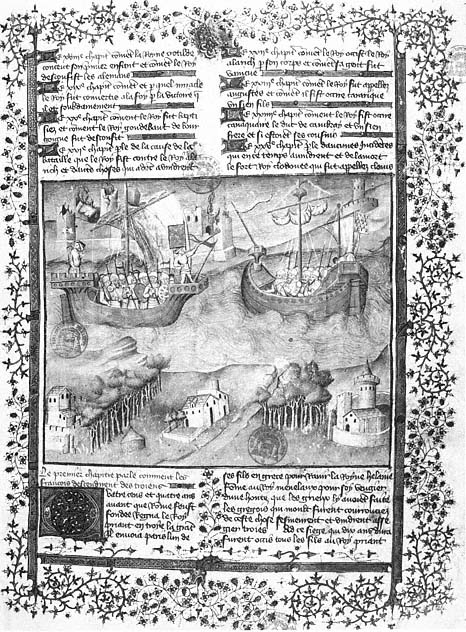
Figure 100
Flight from Troy. Grandes Chroniques de France . Bibliothèque Mazarine, Ms. 2028,
fol. 2. Photograph: Bibliothèque Mazarine, Paris.
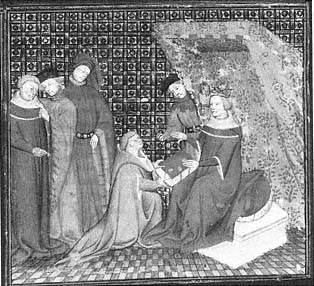
Figure 101
Presentation of book to Charles VI. Grandes Chroniques
de France . Pierpont Morgan Library, M. 536, fol. 2.
Photograph courtesy of the Pierpont Morgan Library.
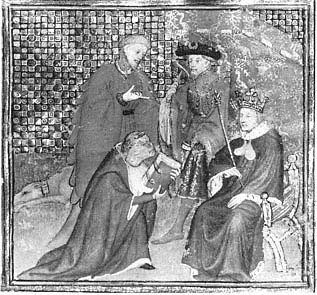
Figure 102
Presentation of book to Charles VI. Grandes Chroniques
de France . Berlin, Deutsche Staatsbibliothek, Phill. 1917,
fol. 1. Photograph: Deutsche Staatsbibliothek Berlin.
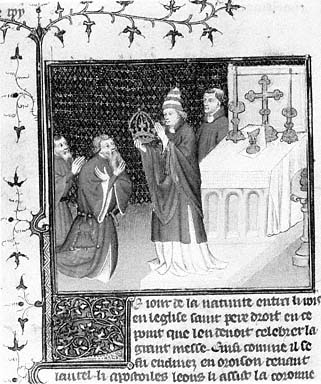
Figure 103
Coronation of Charlemagne. Grandes Chroniques de
France . Pierpont Morgan Library, M. 536, fol. 83v.
Photograph courtesy of the Pierpont Morgan Library.
devices and emblems and relied instead on the cumulative effect of the whole cycle to convey its pictorial message.
In M. 536 broad themes organize the pictures. The reader is not led to recognize themes and interpretations of history by the nonverbal yet explicit use of emblems or devices. Instead his perception is formed subtly by an insistent repetition of subjects and, in a few miniatures, by the use of something as understated as a particularly striking background motif. In this way M. 536 promotes its timely theme—the return of France to good government—and presents the French dukes as the agents who will accomplish this feat.
Two miniatures in M. 536, central to the content of the program, are the coronation of Charlemagne by Pope Leo (Fig. 103) and the coronation of Louis VIII and Blanche of Castile (Fig. 104). Charlemagne's coronation is a standardized scene, identical iconographically to that in Phillips 1917 (Fig. 105). The most innovative feature of the version in the Morgan Library is its background, where an elaborate checkerboard pattern is formed by blue lozenges, each containing a tiny fleur-de-lis. Although variations on this pattern were common in French book illumination in the fifteenth century, it is rare in this manuscript; its only other occurrence is in the miniature illustrating the coronation of Louis VIII.[12] This visual
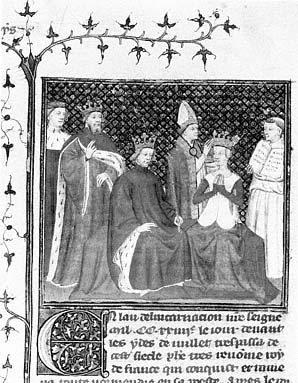
Figure 104
Coronation of Louis VIII and Blanche of Castile. Grandes
Chroniques de France . Pierpont Morgan Library, M. 536,
fol. 224. Photograph courtesy of the Pierpont Morgan
Library.
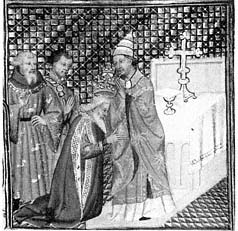
Figure 105
Coronation of Charlemagne. Grandes
Chroniques de France . Berlin, Deutsche
Staatsbibliothek, Phill. 1917, fol. 114.
Photograph: Deutsche Staatsbibliothek
Berlin.
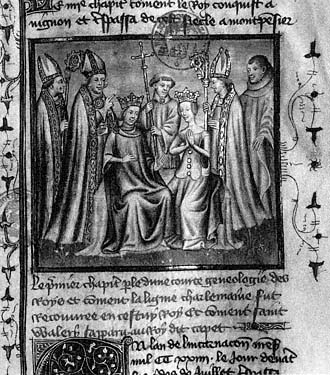
Figure 106
Coronation of Louis VIII and Blanche of Castile. Grandes
Chroniques de France . Bibliothèque Mazarine, Ms. 2028, fol.
263. Photograph by the author.
connection between Charlemagne and Louis VIII reinforces a textual connection recorded in the life of Louis VIII, which includes the reditus regni ad stirpem Karoli Magni , the prophecy that the line of Charlemagne would return to power in France seven generations after the usurpation of power by Hugh Capet. Louis VIII was descended from Charlemagne on both his mother's and his father's sides and thus fulfilled the prophecy.
In M. 536 the miniature showing the coronation of Louis VIII and Blanche of Castile reinforces this dynastic theme by departing from the workshop's stock patterns, exemplified by Louis VIII's coronation from the Grandes Chroniques in Paris (Fig. 106). In the stock scene the clergy alone perform the coronation, but in M. 536 King John of Jerusalem and a duke have prominent places in the scene. Even though the presence of King John is noted in the text, he is rarely included in miniatures showing the event.[13] Thus the inclusion of these two figures in the miniature may convey the support or even, considering John's gesture, the blessing of the secular realm for the return of a ruler of Carolingian descent.
Beginning with the miniature illustrating the life of Louis VIII, the kinds of illustrations in M. 536 change. In the second portion of the book the lively narratives that characterize the illustration of Merovingian, Carolingian, and early
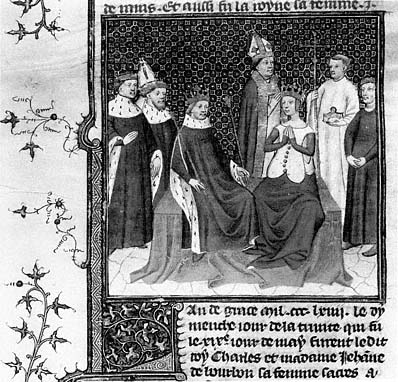
Figure 107
Coronation of Charles V and Jeanne of Bourbon. Grandes Chroniques de
France . Pierpont Morgan Library, M. 536, fol. 353v.
Photograph courtesy of the Pierpont Morgan Library.
Capetian history intermingle with distinctive coronations that prominently feature the dukes of France. Thus, in the coronations of Philip V, Charles V (Fig. 107), and Charles, VI, French dukes assume active roles as king-makers. The power of the ducal presence intensifies with each repetition of the basic composition in a cumulative and deliberate effect. The stress on dukes in coronations in this manuscript differs from that given the same scenes in the Parisian copy of the Grandes Chroniques (Fig. 108) where, for instance, the illustration of Charles V's coronation, like that of Louis VIII, emphasizes the agency of the clergy. Miniatures in M. 536 differ from those in the Brussels manuscript, where, instead of a coronation, a picture like that introducing the life of Charles V (Fig. 109) emphasizes both the king's power and a moment of Burgundian history in which Charles invested his brother, Philip the Bold, with the duchy of Burgundy.
The Burgundian manuscript in the Morgan Library may have a partisan text, but its pictorial message is moderate, claiming only that the dukes have a role in governing France. Pictures in Phillipps 1917 convey a similar message but are more biased. This manuscript, executed in the first decade of the fifteenth century, predates Louis of Guyenne's assumption of power and contains pictures glossed with references to the Burgundian-Orléanist conflict that take a decidedly Burgundian stance.
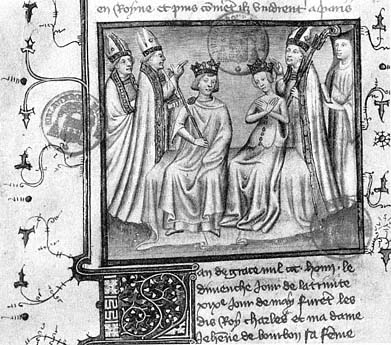
Figure 108
Coronation of Charles V and Jeanne of Bourbon. Grandes Chroniques
de France . Bibliothèque Mazarine, Ms. 2028, fol. 427v.
Photograph by the author.
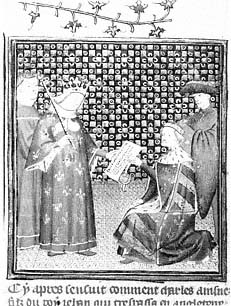
Figure 109
Charles invests Philip the Bold with the
duchy of Burgundy. Grandes
Chroniques de France . Bibliothèque
Royale, Ms. 3, fol. 414v. Copyright
Bibliothèque Royale Albert Ier, Brussels.
The difference between the Burgundian chronicles in New York and Berlin is most clear in the frontispiece. In the frontispiece of M. 536, history and current events are separated; Charles VI takes his place in the fourth frame, and the Trojan story fills the other three frames. Images in Phillipps 1917 do not preserve this distinction of eras. Rather the fifteenth-century emblems and devices introduced in three of the four frames overtly merge different historical periods and refer explicitly to other members of the royal family. The designer is thus able to gloss history without changing the text.
Only one of the scenes in the frontispiece to the Phillipps manuscript is set totally in the early fifteenth century. In the fourth frame of the frontispiece (Fig. 102), the counsellor who stands next to Charles VI is John the Fearless, Charles VI's cousin, who became duke of Burgundy in 1404. John carries a hammer comparable to those he holds in other portraits dating from the first two decades of the fifteenth century.[14] At the same time, details in the Trojan story portrayed in the other frames gloss John's political opponent negatively. In the first frame of the same frontispiece (Fig. 110) Paris's gold collar of mail equates him with Louis of Orléans, Charles VI's brother and John's political rival who was assassinated in 1409. This is a simplified version of the collar of the Order of the Porcupine, which appears in greater detail in a portrait of Louis (Fig. 111) from Christine de Pizan's collected works in London, a contemporary manuscript painted by the same artists.[15] The Order of the Porcupine, sometimes called the Order of the Mail, was founded in 1393 by Louis of Orléans, who often wore the collar with or without its dangling porcupine. Thus Louis of Orléans is identified with Paris, whose passion for Helen of Troy started the Trojan war.
Additional details in the frontispiece may reinforce this negative interpretation. The second frame (Fig. 112) portrays the Greek king Menelaeus who, like John the Fearless, does not appear in M. 536 (Plate 7). Even though his presence is justified by the text of the chronicle, Menelaeus evokes the French king because he wears a blue robe decorated with gold—the heraldic colors, if not the precise emblems, of France. These details of costume added to the pair of miniatures in the upper register provide an extratextual commentary suggesting that, just as Paris stole Helen from King Menelaeus, Louis of Orléans stole Isabeau from Charles VI. If such a reading of the frontispiece was intended, this could be one of the first images to refer to the rumor widely disseminated in Burgundian literature of the 1420S that Louis of Orléans and his sister-in-law, Isabeau of Bavaria, had an illicit relationship.[16]
The differences between the New York and Berlin frontispieces demonstrate the flexibility of the Master of the Cité des Dames's mode of glossing. By adding a few details, he could transform a politically neutral image like the frontispiece to M. 536 into a polemical one. Other emblematic elaborations in Phillipps 1917 reinforce the role of the duke of Burgundy as an especially trusted assistant to King Charles VI. For instance, in the image of the coronation of Charlemagne as emperor (Fig. 105), both the pope and a spectator wear emblems that were popular in the early fifteenth century. The pope's robe is sprinkled with blazing suns that evoke the arms of Pope Alexander V (1409–10), who was supported by the French and elected to end the schism; the most prominent spectator to the left wears a robe covered with schematic planes, emblems of John the Fearless.[17] No complex message is hidden in this scene; rather, the reference to Alexander V situates the
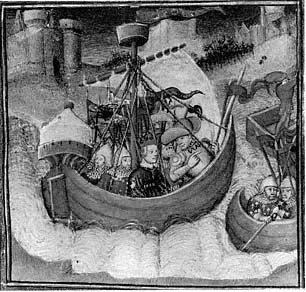
Figure 110
Abduction of Helen. Grandes Chroniques de
France . Berlin, Deutsche Staatsbibliothek, Phill. 1917,
fol. 1. Photograph: Deutsche Staatsbibliothek Berlin.
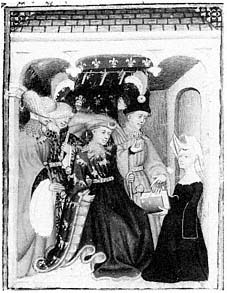
Figure 111
Christine presents her book to Louis of
Orléans. Christine de Pizan, L'Épistre
Othéa . British Library, Harley 4431, fol.
95. By permission of the British Library.
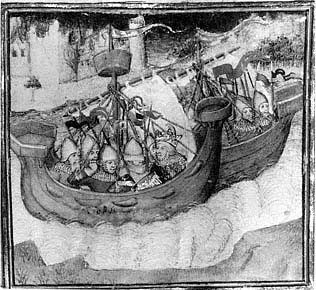
Figure 112
Punishment of Troy. Grandes Chroniques de
France . Berlin, Deutsche Staatsbibliothek, Phill. 1917,
fol. 1. Photograph: Deutsche Staatsbibliothek Berlin.
pictorial gloss in the present, after 1409 when Alexander took office, and the portrayal of John the Fearless assisting at Charlemagne's coronation reiterates the message of the frontispiece—John's loyalty to Charlemagne's namesake, Charles VI.[18]
Phillipps 1917 shares with M. 536 the innovative representation of coronations in which the dukes take an active role. Their basic pictorial vocabulary can be seen, for instance, in representations of the coronation of Charles V and Jeanne of Bourbon (Figs. 107 and 113). Dukes wearing circlets of gold are prominent in each image, and the message—that the dukes contribute significantly to making a king—is clear, particularly when this type of coronation is compared to the Master of the Cité des Dames' s stock scene (Fig. 108).
Although the form and content of individual coronation pictures may be identical in M. 536 and Phillipps 1917, their function in the program of miniatures is not. The Morgan Library's Grandes Chroniques uses such scenes sparingly. The first royal coronation, at the life of Louis VIII, appears within the framework of the reditus , and subsequent scenes of royal coronation (at the lives of Philip V, Charles V, and Charles VI) were doubtless intended to recall that dynastic structure by echoing its compositional type. Coronations in Phillipps 1917 are not so tightly woven into a dynastic framework; rather they are unified by the concept of the Christian kingship of France.
This theme, which found broad popularity in the fifteenth century through the religion royale , is initiated by the first coronation scene in this manuscript, the coronation of Clovis (Fig. 114). Most of the following coronation sequences assume this form, but the coronations of Saint Louis (Fig. 115) and Louis IV (Fig. 116) are more complex compositions. The importance given Louis IX's coronation
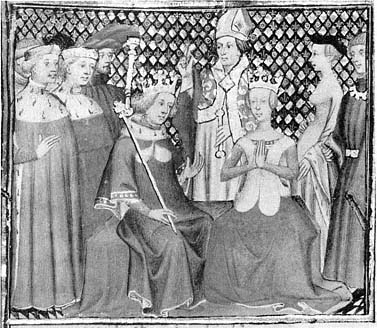
Figure 113
Coronation of Charles V and Jeanne of Bourbon. Grandes
Chroniques de France . Berlin, Deutsche Staatsbibliothek,
Phill. 1917, fol. 484. Photograph: Deutsche Staatsbibliothek Berlin.
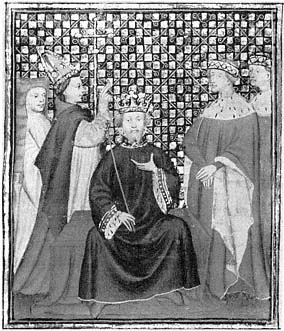
Figure 114
Coronation of Clovis. Grandes Chroniques de
France . Berlin, Deutsche Staatsbibliothek, Phill.
1917, fol. 7v.
Photograph: Deutsche Staatsbibliothek Berlin.
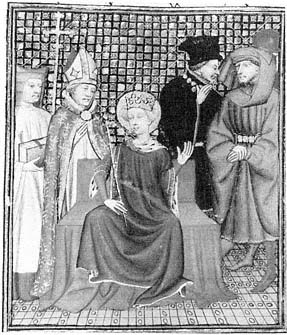
Figure 115
Coronation of Louis IX. Grandes Chroniques
de France . Berlin, Deutsche Staatsbibliothek,
Phill. 1917, fol. 308v.
Photograph: Deutsche Staatsbibliothek Berlin.
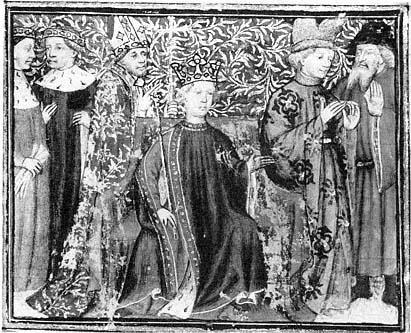
Figure 116
Coronation of Louis IV. Grandes Chroniques de France . Berlin,
Deutsche Staatsbibliothek, Phill. 1917, fol. 199.
Photograph: Deutsche Staatsbibliothek Berlin.
through Louis's halo and the elaborate dress of the attending dukes makes sense both within the context of Christian kingship that governed the form of coronations in this book and within the broader context of devotion to Saint Louis at the French court. Louis's sainthood confirmed the Christian kingship of France that Clovis had initiated, and, as we have seen, Capetian and Valois kings descended from Louis were quick to promote his sanctity.
Louis IV's coronation is the second to represent barons in distinctive costumes. This picture does not celebrate Christian kingship so much as the role of the barons in ensuring continuity. It commemorates the return of the legitimate king to the throne by the barons of France, who brought the young Louis IV back to France after his mother had fled with him to England. Like the distinctive coronation type that occurs throughout M. 536 and Phillipps 1917, this image concentrates on the support of the barons for the monarchy and their action on its behalf. It is tempting to see this image as a reference to a contemporary event in French history. In 1405 John the Fearless and his supporters brought the dauphin back to Paris when his mother, Isabeau of Bavaria, and his uncle, Louis of Orléans, sought to remove him from the capital and free him from Burgundian control.
The frontispiece, the illustration of Charlemagne's coronation, and the generalized representations of coronation demonstrate how pictures in this specific chronicle work as contemporary glosses to establish independent parallels between French history and events from the time of Charles VI. The pro-Burgundian, anti-Orléanist message of this manuscript is cumulative, as in M. 536, but it operates on a simpler level. The pictures and text of M. 536 are so closely interwoven that the message of its pictorial program depends upon a consideration of all its parts. In Phillipps 1917, however, the accumulation of information from a sequence of images may refine the political message, but each individual image contains enough information to convey its message independently.
What is most striking about these two copies of the Grandes Chroniques is that, no matter how the message is conveyed, the underlying call for ducal or baronial responsibility is pervasive. This emphasis on noble support for the king had more parallels in contemporary royalist political writings than in pictorial cycles illustrating previous Grandes Chroniques .
Such authors as Christine de Pizan and Jean Gerson realized the dukes' powers and exhorted them to work for the good of the monarchy. Christine dedicated her works first to Philip the Bold, duke of Burgundy; then to Louis, duke of Orléans; and finally to John, duke of Berry, reflecting her changing opinions about who would be best equipped to govern the realm as custodian for the young dauphin during Charles VI's madness. In times of crisis, Christine and Gerson directly addressed the dukes to encourage them to place the French realm above their own ambitions. After the aborted kidnapping of the dauphin Louis by Louis of Orléans in 1405, Christine's Lettre à la reine and Gerson's sermon, Vivat rex , called for peace and emphasized the importance and the responsibilities of the king and his counsellors, a theme to which Gerson returned again in the sermon, Veniat pax of 1408, and which Christine addressed in Lamentacion sur les maux de la guerre civile in 1410.[19] These texts, like the pictures in the Morgan Library's Grandes Chroniques , expressed the hope current in the first decades of the fifteenth century that the dukes of France would responsibly safeguard the French monarchy rather than expand their own power.
The insistent presence of the dukes in the Grandes Chroniques also mirrors political reality. When these manuscripts were painted, the princes of the blood were actively involved in the government of France, and Burgundian power seemed to be at its strongest. By the end of December 1409, John the Fearless had become sole guardian of Louis of Guyenne and was thus in a position to influence the dauphin, the virtual ruler of France, during Charles VI's attacks.[20] John shared the regency briefly with the duke of Berry in 1410, but by the end of the civil war in 1412, John the Fearless was in a strong position in the government and at the height of his power.
The Role of the Queen and the Dauphin
Equally concerned with contemporary problems, other manuscripts of the chronicle painted by the Master of the Cité des Dames focus on the queen and the dauphin rather than the dukes. The pictures in a Grandes Chroniques now in Paris (Mazarine 2028), which predates the assassination of Louis of Orléans in 1407, provide nonpartisan commentary on the conflict between Louis of Orléans and John the Fearless and the importance of Queen Isabeau of Bavaria's role in politics. A second chronicle, in Brussels (B.R. Ms. 3), dates from the second decade of the fifteenth century when the dauphin, Louis of Guyenne, approached his maturity; some of its images refer to the importance of his education. Together these books address additional issues of concern to the court and to Parisian intellectual circles in the first part of the fifteenth century. Like the chronicles in Berlin and New York, they could be termed royalist books. They support those who sought to preserve the French monarchy but concentrate on different agents of preservation.
An imposing frontispiece and three rare subjects gloss French history with contemporary commentary in the Grandes Chroniques from the Bibliothèque Mazarine. As in Phillipps 1917, pictures in this chronicle include arms and devices that identify figures from French history with contemporary personages. They celebrate the French dynasty and comment on the civil war in France.
The Trojan frontispiece (Fig. 100) embodies a dynastic theme. Within this miniature, two boats fleeing the burning city of Troy display the arms of France and Brittany. This juxtaposition is perplexing at first, because the text of the chapter describes the refugees from Troy but does not mention the Bretons. Instead, the chronicle notes three major countries founded by Trojan refugees: Italy, founded by Aeneas; Britain, by Brut; and France, by Francion.
This use of Breton arms becomes clear when we consider the source for the description of Brut's life in the Grandes Chroniques , Geoffrey of Monmouth's History of the Kings of Britain .[21] Geoffrey's text stresses the interrelated histories of Britain and Brittany, which was colonized by the descendants of Brut. When Britain was in difficulty, the Bretons sent armies to aid their island relatives. War, pestilence, and famine, however, eventually defeated the Britons, who emigrated as a nation to Brittany. Thus, as Geoffrey of Monmouth describes it, "From that time, the power of the Britons ceased in the island, and the Angles began their reign."[22] Although the Grandes Chroniques never refers explicitly to the history of Brittany, it does echo Geoffrey: "From this Brut descended all the kings who were in the land [Britain] up until the time when the English, who came from one of
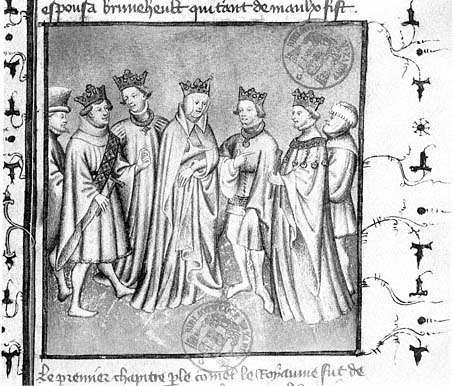
Figure 117
Queen Clotilda divides the realm among her sons. Grandes Chroniques de France .
Bibliothèque Mazarine, Ms. 2028, fol. 14. Photograph by the author.
the countries of Saxony called Angle, took the land for which [reason] it is called England."[23] We could say, then, that the Trojan refugees in this miniature bear Breton arms because the Bretons, rather than their English supplanters, were of Trojan descent.
Contemporary history provides another motive for the use of Breton arms. In 1396, Jeanne of France, third daughter of Charles VI and Isabeau of Bavaria, married John of Montfort, heir to the duchy of Brittany.[24] The alliance of these two houses was politically motivated. Notoriously independent, Breton dukes placed the security of their duchy before their duties as vassals of the French king. By securing a marriage tie with the Breton house, the French sought to strengthen relations between the Bretons and the French. The heraldic display in the frontispiece thus implies that the recent connection of the two houses has its roots in their shared Trojan ancestry.
Other pictures in the chronicle refer to internal French politics. For example, the illustration to the second book (Fig. 117) shows Queen Clotilda dividing the realm among her four sons, pictured as kings. Two of these kings have special attributes: the king at the far right clasps a stick, and the king at the far left holds a schematized hammer. These are generalized references to the political emblems of Charles VI's brother and cousin—the bâton noueux or knotty stick of Louis,
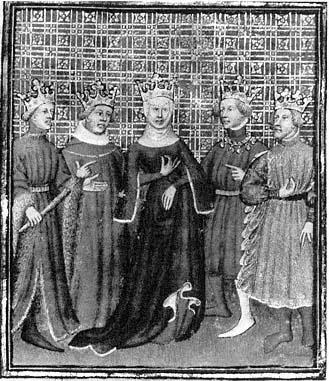
Figure 118
Queen Clotilda divides the realm among her sons. Grandes
Chroniques de France . Berlin, Deutsche Staatsbibliothek,
Phill. 1917, fol. 14. Photograph: Deutsche Staatsbibliothek Berlin.
duke of Orléans, and the hammer of John the Fearless, duke of Burgundy.[25] The history of Queen Clotilda's sons clarifies the references to these noble cousins.[26] After Clotilda partitioned the realm, two of her sons formed a greedy alliance to battle one of their brothers. Only Queen Clotilda's active intervention prevented fratricide. The use of Burgundian and Orléanist emblems in a scene of Clotilda and her sons may therefore comment on the deadly rivalry between these blood relations of Charles VI.
The timeliness of this image is confirmed by representations in the two later manuscripts of the Master of the Cité des Dames , neither of which includes the simplified hammer. In the pro-Burgundian manuscript, Phillipps 1917, for example (Fig. 118), Clotilda's son at the far left is the only one to retain his emblem. Without the opposing hammer, the baton loses its overlay of political meaning and serves as a neutral sign of office.[27]
The inclusion of Clotilda with her sons may also address a second theme that permeated royalist, as opposed to Burgundian or Orléanist, political writings of the early fifteenth century—the importance of the queen in governing the realm. Certainly the theme of queenly power is expressed in two other pictures from the Paris manuscript: the coronation of Charlemagne's son, Louis the Pious, as King of Aquitaine (Fig. 119) and the discussion of the royal succession after the death
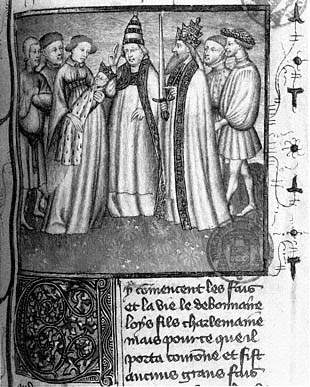
Figure 119
Coronation of Louis the Pious as king of Aquitaine.
Grandes Chroniques de France . Bibliothèque
Mazarine, Ms. 2028, fol. 131. Photograph by the author.
of the last Capetian king (Fig. 120). Never before had queens been included in these scenes. The second in particular shows the queen, an expectant mother, as an important protagonist in discussions about the future government of France. Probably because of the short lives of French dauphins (three had died by 1397), the image recalls an important theme in contemporary politics and literature—Queen Isabeau of Bavaria's role in the government of France and the hope that she would interfere to regulate the chaos caused by the rivalry of the dukes.
The major source of Isabeau's power was her role as one of the regents charged with the tutelle , or education, of the dauphin in case the king should die or be absent from the realm.[28] Charles V had been the first king since Saint Louis to give such a prominent role to the queen. His laws were adopted by Charles VI and his council in 1393—right after Charles's first attack of insanity—and remained in effect until 1407.[29] Under their provisions, Louis of Orléans became regent if the king died or was "absent," and Isabeau of Bavaria and the dukes of Burgundy and Berry were charged with the education of the prince. As royalist writers like Christine de Pizan recognized, Isabeau's role as guardian of the dauphin and peacemaker in a regency government became especially important once the dukes of Burgundy and Orléans became openly hostile in 1405.[30]
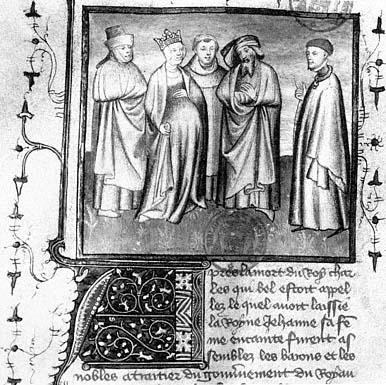
Figure 120
Discussion of the royal succession. Grandes Chroniques de France .
Bibliothèque Mazarine, Ms. 2028, fol. 354v. Photograph by the author.
The close relationship between royalist sentiment and pictorial imagery in the Grandes Chroniques in Paris continues in later chronicles by artists from the Cité des Dames workshop. The Grandes Chroniques in Brussels (B.R. 3) dates from the second decade of the fifteenth century when Charles VI's heir, Louis of Guyenne, was in his early teens. Perhaps as a result of the dauphin's maturity, distinctive miniatures in this book focus exclusively on the importance of the education of dauphins.
Three pictures in this book show the interaction of a king and his son. One shows King John the Good, Charles VI's grandfather, investing his young son, Charles, with the Dauphiné (Fig. 121). Two others offer examples of good and bad kingship that were especially appropriate to a dauphin named Louis. The miniature beginning Louis the Stammerer's life (Fig. 122) shows Louis compromising himself to gain power; he gives the barons anything they want in order to win their favor. In the process, Louis grasps his son's wrist to compel him to participate. A complementary image from another section of the chronicle shows the prince's willing compliance when his father is a positive influence. In this picture from the beginning of the life of Saint Louis (Fig. 123), the young Louis sits next to his father, Louis VIII, and helps supervise the burning of heretics.
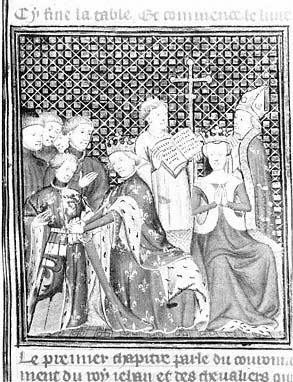
Figure 121
John the Good invests Charles with the Dauphiné.
Grandes Chroniques de France . Bibliothèque Royale,
Ms. 3, fol. 373.
Copyright Bibliothèque Royale Albert Ier, Brussels.
Neither miniature faithfully reflects the chronicle's text.[31] Louis the Stammerer had two sons—Louis and Carloman—neither of whom was mentioned in the chapter that this picture illustrates. Further, Saint Louis did not take part in his father's persecution of heretics; his father was in the south of France and Louis was in Paris. By departing from the text in representing kings with heirs named Louis, the artist created compositional and thematic analogies. They were apt choices for exempla at the time when Charles VI's son, Louis of Guyenne, was dauphin.
Like the emphasis on queenship in the Grandes Chroniques now in Paris, the focus on the dauphin in B.R. 3 paralleled contemporary historical events and reflected concerns expressed in contemporary literature. The ordinance of 1407 empowering Louis of Guyenne to rule during his father's "absences" made the dauphin the most important person in the realm besides the king. His education was addressed by Christine de Pizan in several works and by Jean Gerson in a treatise sent to the tutor of the dauphin, Jean d'Arsonval, and dated between 1408 and 1414.[32] These writings discussed the religious, moral, and intellectual formation of the future king and frequently cited examples of past kings, most notably Louis of Guyenne's famous ancestor, Saint Louis, as models of government.
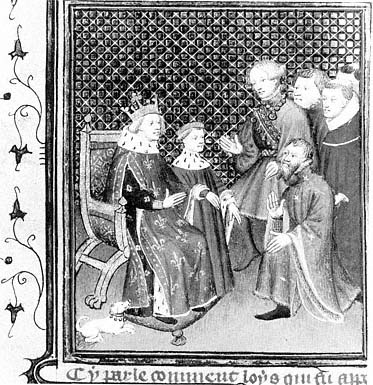
Figure 122
Louis the Stammerer and his son Louis accede to barons.
Grandes Chroniques de France . Bibliothèque Royale, Ms. 3,
fol. 147v. Copyright Bibliothèque Royale Albert Ier, Brussels.
Manuscripts decorated by the Master of the Cité des Dames provide insights into a special kind of courtly reaction to the French civil war. Like the illustrations in royal manuscripts before them, these images of history form a private complement to more overt political writings, featuring images of the contemporary powers in France—the dukes and the queen—and representing themes like the role of the dukes in governing France, the Burgundian-Orléanist conflict, the importance of the queen as mediator and peacemaker, and the education of the dauphin. As in the political literature of the time, these images offer an important perspective on the political climate of fifteenth-century France.
The Master of the Cité des Dames used various methods of illustration to gloss the chronicle and express his political message. The simpler way is to elaborate an individual picture that, when read with its own text, comments on contemporary events. This sort of elaboration ranges from the inclusion of characters described in the text but rarely visualized (as in Jeanne of Evreux's presence at the discussion of the royal succession in Mazarine 2028), to the addition of historical characters who contradict their text (Saint Louis happily burning heretics in B.R. 3), to the insertion of anachronistic emblems and devices into stock scenes (as in the Burgundian hammer and the Orléanist Order of the Porcupine in the frontispiece
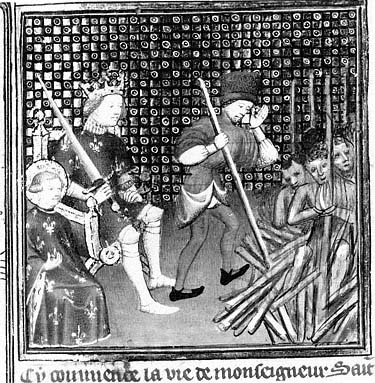
Figure 123
Louis VIII and his son Louis supervise the burning of heretics.
Grandes Chroniques de France . Bibliothèque Royale, Ms. 3,
fol. 248. Copyright Bibliothèque Royale Albert Ier, Brussels.
of Phillipps 1917). In these glosses, immediately perceptible to a careful reader of one chapter or the whole manuscript, the overarching message of the program of decoration conveys the same message as each individual part.
The Master of the Cité des Dames' s more complicated method of glossing encompasses the whole program of decoration. In this system, most commonly seen in kings' books, individual pictures carry only a portion of the message. Images work in sequences, building a message through repeated compositions (as in the series of coronations in M. 536) or through visual cross-referencing (as in the pair of exempla for the education of the dauphin in B.R. 3). The message of the whole is much more than a sum of its parts—and often is very subtle, perhaps explaining why this kind of cycle occurs most frequently in manuscripts like that in New York where the text has been edited to promote a partisan view.
These manuscripts provide important evidence for a changing view of history in the fifteenth century. In the late fourteenth and the early fifteenth century the princes of the blood emerged simultaneously as major participants in government and as important patrons of the arts,[33] and during the reign of Charles VI the blood relations of the king began to assume a special status—to share, in a sense, some of the holiness of the French king, as they shared some of the responsibilities
of government. At this time, therefore, the decorative programs in the Grandes Chroniques worked to extend to the king's blood relations the prologue's directive that the king should seek models in its pages. The conviction, held by the princes of the blood and the court, that the blood relations of the king also had a mandate to govern inspired the creation of such advice books as the Grandes Chroniques decorated by the Master of the Cité des Dames .